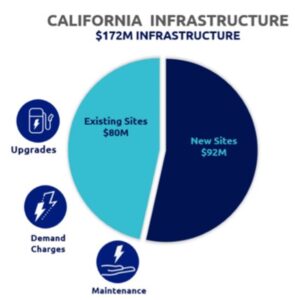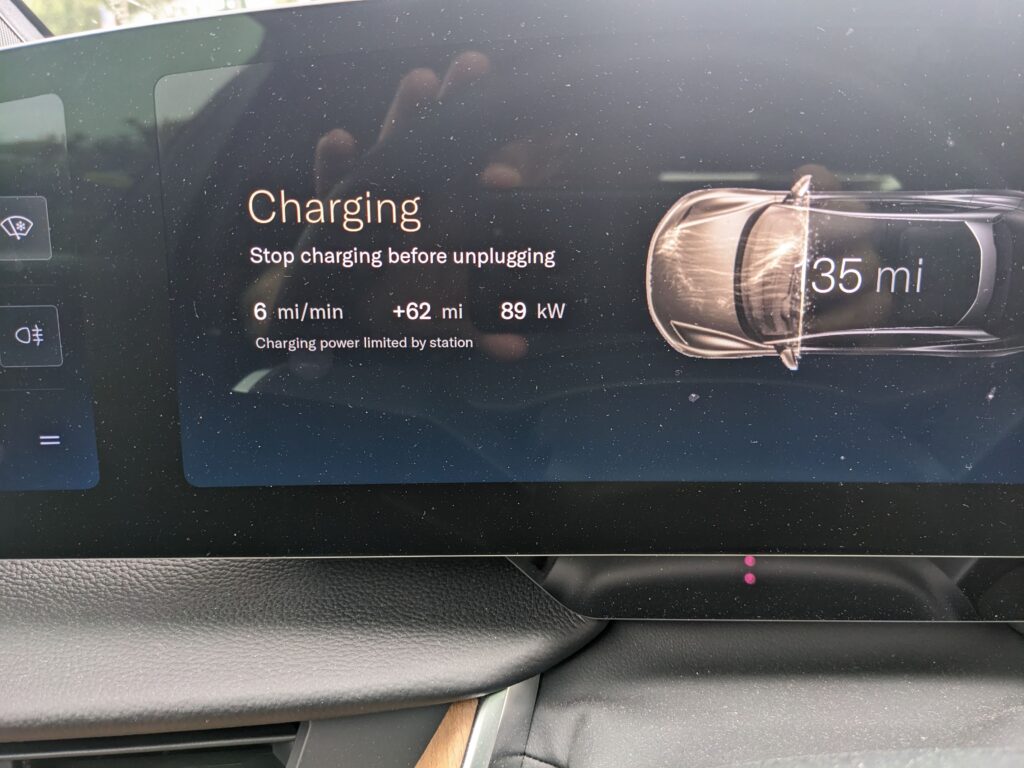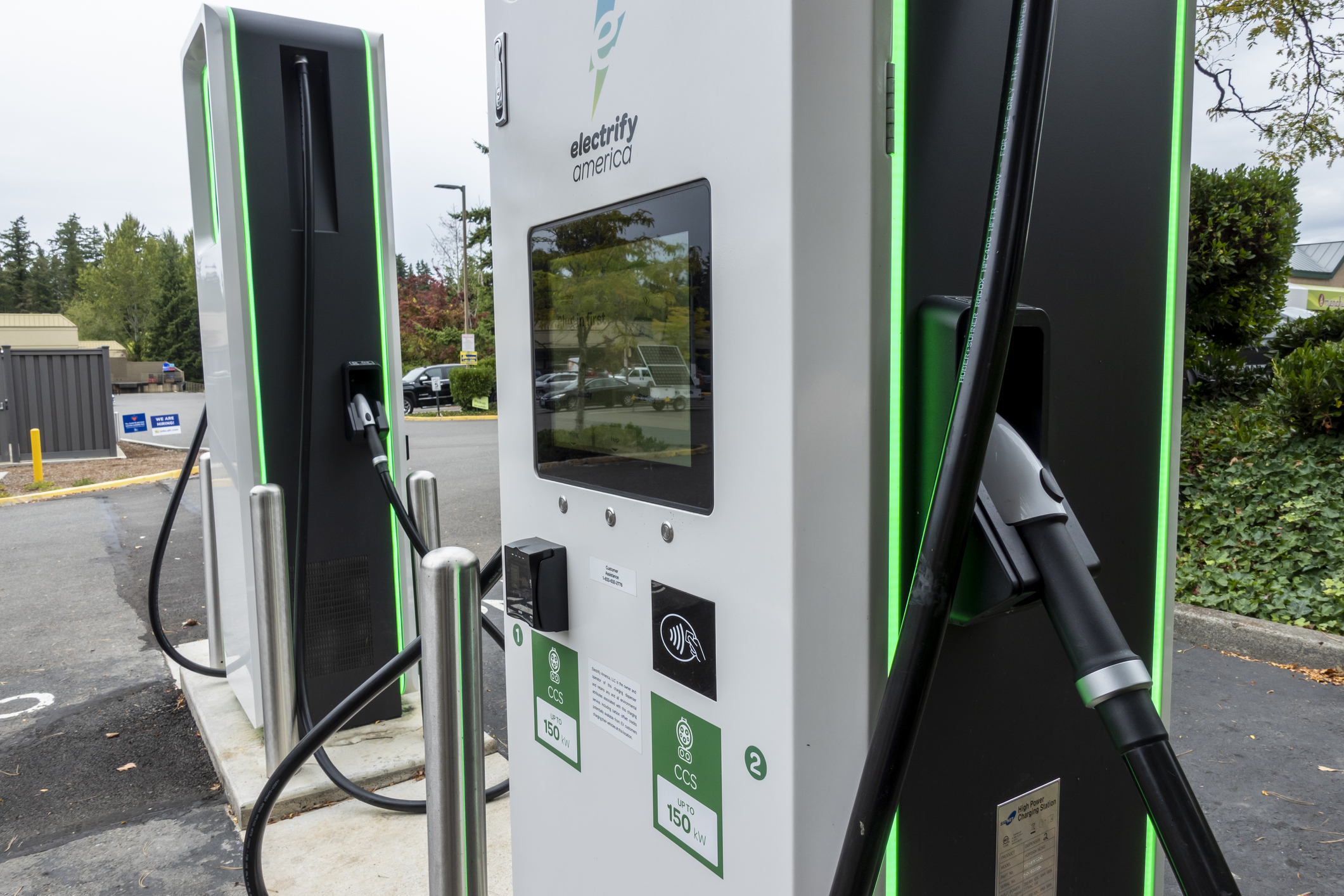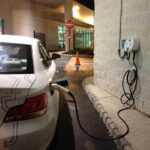TL;DR
I recently pulled into an Electrify America 350 kW-capable DC Fast Charging (DCFC) station, and while the charging session initiated right away, I was getting a mere 30 kW while my car requested nearly 10 times that amount. That’s when I started researching this article.
All DCFC networks are a work in progress. Perhaps none more so than Electrify America (EA). To state the obvious, Tesla’s Supercharging network was born of necessity as a catalyst to help the brand and encourage EV adoption. Similarly, the ChargePoint and EVgo networks were founded as businesses with the ability to make their own decisions and priorities while also turning a profit for their shareholders.
Electrify America was brought into existence by U.S. government mandate as part of the settlement of Volkswagen’s Dieselgate scandal. Fines paid by VW go to EA as directed by the court to build out and maintain a charging network.
To understand EA, we must go down the rabbit hole and “follow the money,” pursuing court documents and development plans approved by the Environmental Protection Agency (EPA) and the California Air Resources Board (CARB). We will learn that the budget to maintain Electrify America’s network has been unintentionally constrained by the courts, but that is coming to an end.
Let’s dive in.
The Nitty Gritty Details of Electrify America’s Network
Electrify America’s network has come under criticism for its lack of reliability in recent months. This is acknowledged by EA, as the Cycle 3 Plan previously touted its user satisfaction1, yet less than four years later, the Cycle 4 Plan notes that user satisfaction has slipped and there is an increased commitment to maintenance2. This criticism is also abundant in the press as well as on social media.
Spoiler alert – As viewed through the lens of the CARB and EPA-approved, court-ordered development plans, Electrify America’s network gets an A+. And most people would agree that Electrify America has successfully built an enormous network of chargers in the locations where people need them. Drive on many major highways in the U.S., and you’re likely to find EA charging stations just off the road, spaced 1-2 hours apart.
But when it comes to those chargers actually working when you need them to, that grade slips to a C-. But the time-honored excuse of “my dog ate my homework” actually sort of works for EA. We’ll get to that in a bit. Understanding the background of this story explains why Electrify America’s network is a work in progress more so than others.
By Order of the Court
Electrify America was formed in the wake of Volkswagen’s “Dieselgate” scandal. A quick refresher is in order. The diesel engine was a very popular and economical choice in Europe in the 80s and 90s and only a bit less popular in the US. But in the early 2000s, tightening worldwide emission standards made diesels problematic. To preserve their popular diesel engines, the Volkswagen Group tried to dodge these emission standards by installing a cheat device that sensed when the car was being tested and modified several engine parameters to allow it to pass.
Unfortunately, those same engine parameters wouldn’t allow the engine to develop enough power to be useful in real-world conditions.
Volkswagen got caught in 2015 and was sued by the US District Attorney’s Office, the EPA, and the California Resources Board (CARB). Volkswagen paid huge fines, initiated buybacks of affected cars, and so forth.
One of the penalties to be paid by Volkswagen, and the subject of today’s column, is documented in the 2.0-Liter Partial Consent Decree entered by the U.S. District Court for the Northern District of California on October 25, 20163. Landing with a bit of a thud on one’s desk at 226 pages, the Decree contains details for far more than just the creation of EA. The basis of EA is contained in Appendix C, and at a skosh bit more than 23 pages, it is far more manageable than the full Decree. It is also written in legalese and is more powerful than Ambien. Nevertheless, it is required reading for all who wish to understand how and why Electrify America’s network operates as it does.
Appendix C of the Decree outlines two separate Investment Plans, one for California and one for the rest of the U.S. The California investment plan calls for a total of $800M to be invested in the state of California over a 10-year period to, among other things, build out EV charging infrastructure. This $800M investment is administered by the court, but the important part to understand is that this investment plan must be approved by CARB. The 10-year investment is broken up into four 30-month cycles of $200M each and has its specific CARB-approved plan for each of those four cycles.
Similarly, Appendix C also outlines a National Plan to build out EV charging infrastructure over a 10-year period. The National Plan is approved by the EPA and covers the remaining 49 states. It also includes four 30-month cycles, but the National Plan distributes $300M each cycle for a total of $1.2B.
As stated in the opening sentence in the Decree’s Appendix C, one of the purposes of the Dieselgate settlement is for the “… development, construction, and maintenance of zero-emission vehicle-related infrastructure.” We’ll address the maintenance clause in detail separately, but focusing on the development and construction of charging infrastructure, Electrify Ameria’s network gets an A+ by virtually any measure.
In the roughly seven years since the Decree, EA has installed 3,702 DCFC stations. Additionally, they acquired building permits and negotiated lease agreements for 252 separate charging locations across the U.S., representing 843 stations, with another 118 coming soon. Electrify America has also deployed over 2,828 Level 2 workplace and multi-family housing charging ports. In terms of its national footprint and brand name awareness, Electrify America’s network is second only to Tesla, which has had the benefit of an additional five-year head start.
Takeaway Number One is that EA has succeeded in building out a brand and a network all within the first seven years of its 10-year investment plan.
Network Maintenance and the Implicit Impact of the 30-Month Planning Cycle
The two investment plans (California plus the National plans) started their first 30-month cycle in January 2017. The investment plans are well into the third cycle, with the fourth cycle beginning in July 2024. The fourth investment cycle represents the final allocation per the Decree regarding Volkswagen’s liability in the Dieselgate scandal.
The Cycle 4 Plan was crafted during 2023. CARB approved the California plan in October 2023. As of this writing, the National Plan has yet to receive EPA approval. As with the three plans that preceded it, this fourth investment plan will be executed over a 30-month period beginning July 2024. From the closing of the commenting period for the fourth cycle ending June 30, 20234 to when the investment cycle begins is 13 months, and a full 43 months until the investment cycle ends. Four years is a long time in the fast-paced EV industry, and you’d need one powerful crystal ball to predict everything right.
Common to each 30-month investment plan is how EA is allowed to spend the funds, as ordered by the court, with penalties if the goals of the plan are not met5.
Takeaway Number Two is that once the spending plan has been approved by the appropriate authority, flexibility in the spending plan is limited.
Details on Plans, Spending, and Court-Ordered Penalties
To simplify the discussion, the following paragraphs focus on the California Cycle 3 and 4 plans as approved by CARB. The National Plan (approved by the EPA) and CARB-approved Cycles 1 and 2 all have similar contours, albeit with different details.
What jumped out to me while comparing the Cycle 3 and 4 investment plans is how the topic of maintenance is approached. In the Cycle 3 plan, the importance of maintenance is mentioned6, but there is no specific line item in the $127M (out of $200M) allocated to infrastructure – maintenance simply falls under the umbrella of “infrastructure” with no top line allocation mentioned. Also falling under Cycle 3, the $127M allocated for infrastructure was committed to deploying up to 116 new DCFC stations across the state7 with stiff penalties for missing the approved targets. By conjecture, the new infrastructure must go in, or else penalties must be paid.
That may have been the right call when CARB approved the Cycle 3 plan in January 2021, but what happens as Cycle 3 progresses and the need for more maintenance than planned arises? Cycle 3 had already been approved. Costs to cover unplanned maintenance simply must come from other sources. The implication is that, without additional funding, maintenance suffers at the expense of meeting the CARB-approved Cycle 3 Plan without incurring court-enforced penalties. We reached out to EA for comment, but received no reply.
Reading between the lines of the Cycle 4 Plan, it is evident that EA has internalized customer feedback8 by not only allocating a budget line item, but 40% of the overall budget is allocated to upgrades and improved reliability at current sites9.
In defense of the 30-month cycle, the court wisely sought accountability for how the $2B set aside by the Decree should be spent on behalf of the public good. In retrospect, annual feedback cycles may have prevented some of the failures that consumers have observed.
Takeaway Number Three is if there was any failure on the part of EA to maintain its infrastructure, it is due at least partly to the rapid growth of EVs exacerbated by the court-ordered 30-month feedback cycle. EA has simply never had the flexibility to react to a changing market on the same quarterly (or even monthly) basis afforded to its competitors.
To Cycle 4, and Beyond!
I rewrote this article three times as deeper dives into the documentation revealed new plot threads. The end result is not what I initially thought it would be.
This article started by saying that Electrify America’s network is a work in progress, perhaps more so than other networks. One thing that will immediately change for Electrify America’s network will occur in January of 2027, and that is when the 30-month investment plans approved by CARB and the EPA will cease. In their place will be annual plans with quarterly adjustments approved by a board of directors, similar to essentially every other business operation.
One thing that stands out after many late nights bleary-eyed reading legalese is the commitment to invest $80M in upgrades and maintenance during Cycle 4 just within the state of California (national numbers are not yet available, but presumed to be similar). Anyone left doubting that EA did not get the memo on customer frustration levels, specifically at its sites, should read Section 5.3 in the Cycle 4 Plan in its entirety and note the contrast compared to the self-congratulating nature of the following10 quote from the previous plan published about 30 months earlier:
Electrify America has achieved industry leading quality – in December 2020 Electrify America received CHARGED EV’s Charging Infrastructure Best-in-Test award. In addition, our scores on PlugShare, a social application that allows users to find and rate charging stations, exceed those of all other large open DCFC networks.
Takeaway Number Four is that Cycle 4 has carved out the capital required for upgrades and maintenance, and changes are coming. After Cycle 4, Electrify America will be fully empowered to manage its own destiny. To that end, EA has already demonstrated that it is thinking past Cycle 4 with deals like the recent $450M investment from Siemens.

Unlike Cycle 3, the Cycle 4 Plan brings maintenance of existing sites to a specific budgetary line item, with a size nearly as large as what the Biden Administration allocated for the entire U.S. Image from the EA Cycle 4 Plan.
Networks implementing DCFC infrastructure have high upfront capital costs and significant touch labor, all for dispensing what is essentially a commodity – not too dissimilar from airlines, which are regulated and have seen consolidation in recent decades. So it does not seem farfetched to assume that those two things may be in store for charging networks in the decades to come.
A Final Word on Customer Satisfaction
Consumers will reward the networks that connect and charge their car the first time, and deliver the power the car requests. That is my litmus test for a successful charge, and one that is overlooked in public policy.

When I complained about being throttled at 89 kW, a friend reminded me that 5 years ago, I’d be thrilled to get 89 kW. That may be true, but that’s beside the point. A successful charge is one that initiates on the first plug-in, and the station delivers the power the car is requesting, up to the maximum output the station can deliver. Photo credit: John Higham.
Lastly, the easiest way to improve the customer experience is to implement idle fees and an incremental fee structure that motivates EV drivers to move off of the high-power DCFC as their cars approach the part of the charge cycle that could be adequately supported by Level 2 – and provide that Level 2 charging equipment. Tesla has already started this with its congestion fee.
The entire industry needs to rethink itself as a customer service organization, not just in terms of charging a vehicle but also in providing services to meet drivers’ needs where they are and while they charge. Anything from free wifi, an on-site gym, or even laundry pickup services will keep customers coming back.
______________________________
Footnotes:
1Section 2 in the Cycle 3 Plan
2Section 5.3 in the Cycle 4 Plan
3Section 2.12 of Appendix C of the Decree outlines penalties
4Section 4.4 in this document
5The 2016 2.0-Liter Partial Consent Decree of in shorthand, or simply the Decree
6Section 4.9 in the Cycle 3 the importance of maintenance is discussed, but no plans or details given
7Tables 4, 5 & 6 in the Cycle 3 Plan
8Section 5.3 in the Cycle 4 Plan
9Figure 2 in the Cycle 4 Plan
10Section 2 in the Cycle 3 Plan








When it comes to services drivers need while charging, skip the WIFI and back rubs, lets go for the low hanging fruit like a canopy!!! so you can connect and disconnect in the rain without being soaked, or maybe a trash can or two. If you want to get crazy, how about toilets, okay port-a-potties then. All this self admiration from EA for the one fancy new station in SF, is offensive, while most of us stand in the cold rain trying to connect or disconnect to keep the line moving. And why did CA get 2.5 times as much money as the rest of the country?
California got more of the Dieselgate funds because it was the California Air Resources Board who uncovered VW’s illegal activities and pursued the settlement.